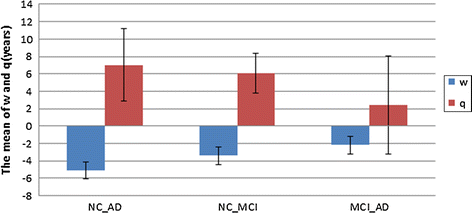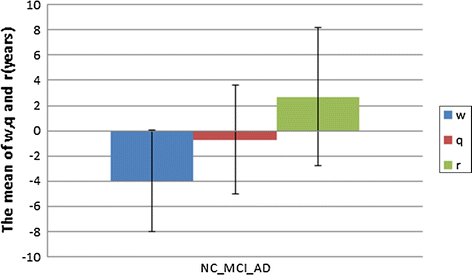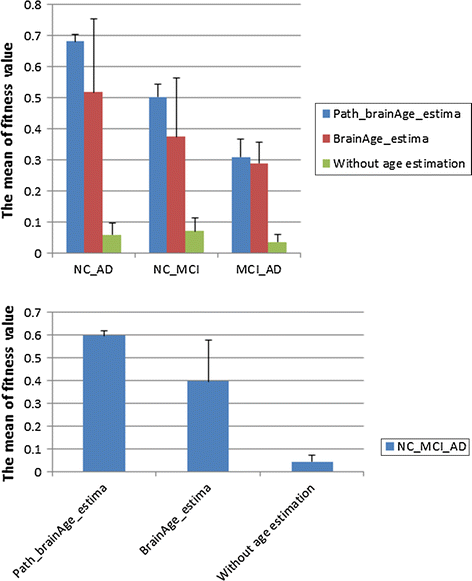Dependency criterion based brain pathological age estimation of Alzheimer's disease patients with MR scans
- PMID: 28438167
- PMCID: PMC5404315
- DOI: 10.1186/s12938-017-0342-y
Dependency criterion based brain pathological age estimation of Alzheimer's disease patients with MR scans
Abstract
Objectives: Traditional brain age estimation methods are based on the idea that uses the real age as the training label. However, these methods ignore that there is a deviation between the real age and the brain age due to the accelerated brain aging.
Methods: This paper considers this deviation and obtains it by maximizing the correlation between the estimated brain age and the class label rather than by minimizing the difference between the estimated brain age and the real age. Firstly, set the search range of the deviation as the deviation candidates according to the prior knowledge. Secondly, use the support vector regression as the age estimation model to minimize the difference between the estimated age and the real age plus deviation rather than the real age itself. Thirdly, design the fitness function based on the correlation criterion. Fourthly, conduct age estimation on the validation dataset using the trained age estimation model, put the estimated age into the fitness function, and obtain the fitness value of the deviation candidate. Fifthly, repeat the iteration until all the deviation candidates are involved and get the optimal deviation with maximum fitness values. The real age plus the optimal deviation is taken as the brain pathological age.
Results: The experimental results showed that the separability of the samples was apparently improved. For normal control- Alzheimer's disease (NC-AD), normal control- mild cognition impairment (NC-MCI), and mild cognition impairment-Alzheimer's disease (MCI-AD), the average improvements were 0.164 (31.66%), 0.1284 (34.29%), and 0.0206 (7.1%), respectively. For NC-MCI-AD, the average improvement was 0.2002 (50.39%). The estimated brain pathological age could be not only more helpful for the classification of AD but also more precisely reflect the accelerated brain aging.
Conclusion: In conclusion, this paper proposes a new kind of brain age-brain pathological age and offers an estimation method for it that can distinguish different states of AD, thereby better reflecting accelerated brain aging. Besides, the brain pathological age is most helpful for feature reduction, thereby simplifying the relevant classification algorithm.
Keywords: Alzheimer’s disease; Brain age estimation; Brain pathological age; Classification; Correlation criterion; Magnetic resonance imaging; Support vector regression.
Figures




Similar articles
-
Estimating the brain pathological age of Alzheimer's disease patients from MR image data based on the separability distance criterion.Phys Med Biol. 2016 Oct 7;61(19):7162-7186. doi: 10.1088/0031-9155/61/19/7162. Epub 2016 Sep 20. Phys Med Biol. 2016. PMID: 27649031
-
Classification of Alzheimer's disease and prediction of mild cognitive impairment-to-Alzheimer's conversion from structural magnetic resource imaging using feature ranking and a genetic algorithm.Comput Biol Med. 2017 Apr 1;83:109-119. doi: 10.1016/j.compbiomed.2017.02.011. Epub 2017 Feb 27. Comput Biol Med. 2017. PMID: 28260614
-
A Novel Grading Biomarker for the Prediction of Conversion From Mild Cognitive Impairment to Alzheimer's Disease.IEEE Trans Biomed Eng. 2017 Jan;64(1):155-165. doi: 10.1109/TBME.2016.2549363. Epub 2016 Apr 1. IEEE Trans Biomed Eng. 2017. PMID: 27046891
-
Frontiers for the Early Diagnosis of AD by Means of MRI Brain Imaging and Support Vector Machines.Curr Alzheimer Res. 2016;13(5):509-33. doi: 10.2174/1567205013666151116141705. Curr Alzheimer Res. 2016. PMID: 26567735 Review.
-
Characterization of brain samples in studies of aging, Alzheimer's, and other neurodegenerative diseases.Neurobiol Aging. 1993 Nov-Dec;14(6):539-45. doi: 10.1016/0197-4580(93)90037-c. Neurobiol Aging. 1993. PMID: 8295656 Review.
Cited by
-
Localized instance fusion of MRI data of Alzheimer's disease for classification based on instance transfer ensemble learning.Biomed Eng Online. 2018 May 2;17(1):49. doi: 10.1186/s12938-018-0489-1. Biomed Eng Online. 2018. PMID: 29716598 Free PMC article.
-
Retinal Aging in 3× Tg-AD Mice Model of Alzheimer's Disease.Front Aging Neurosci. 2022 Jun 16;14:832195. doi: 10.3389/fnagi.2022.832195. eCollection 2022. Front Aging Neurosci. 2022. PMID: 35783138 Free PMC article.
-
Hierarchical Rough-to-Fine Model for Infant Age Prediction Based on Cortical Features.IEEE J Biomed Health Inform. 2020 Jan;24(1):214-225. doi: 10.1109/JBHI.2019.2897020. Epub 2019 Feb 1. IEEE J Biomed Health Inform. 2020. PMID: 30716056 Free PMC article.
-
Brain age and other bodily 'ages': implications for neuropsychiatry.Mol Psychiatry. 2019 Feb;24(2):266-281. doi: 10.1038/s41380-018-0098-1. Epub 2018 Jun 11. Mol Psychiatry. 2019. PMID: 29892055 Free PMC article. Review.
-
Brain Aging in Patients With Cardiovascular Disease From the UK Biobank.Hum Brain Mapp. 2025 Jun 1;46(8):e70252. doi: 10.1002/hbm.70252. Hum Brain Mapp. 2025. PMID: 40489382 Free PMC article.
References
-
- Diciotti S, Ciulli S, Ginestroni A, Salvadori E, et al (2015) Multimodal MRI classification in vascular mild cognitive impairment. Conference Proceeding of IEEE Engineering Medical Biology Society. p 4278–81. - PubMed
Publication types
MeSH terms
LinkOut - more resources
Full Text Sources
Other Literature Sources
Medical
Research Materials

